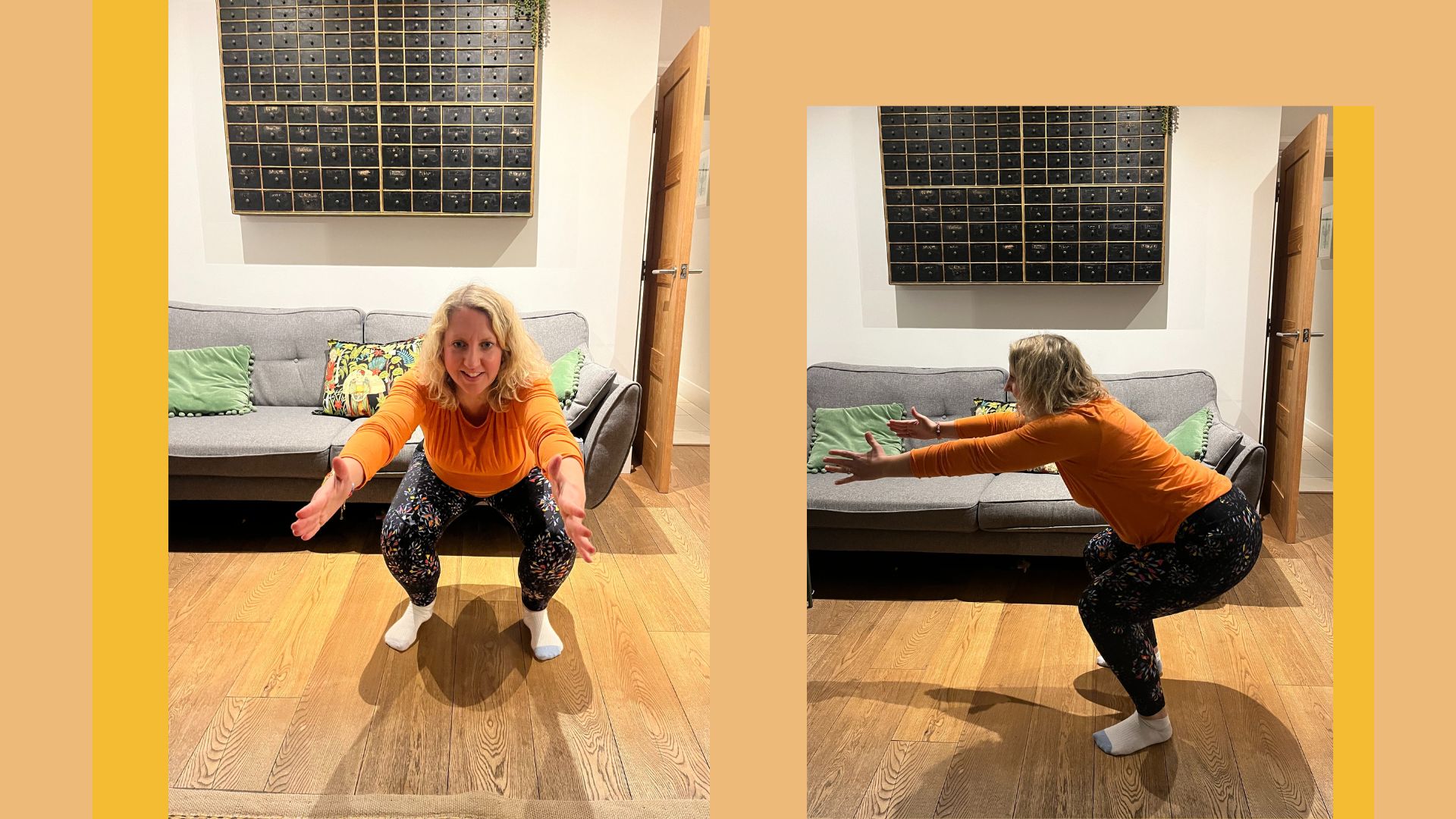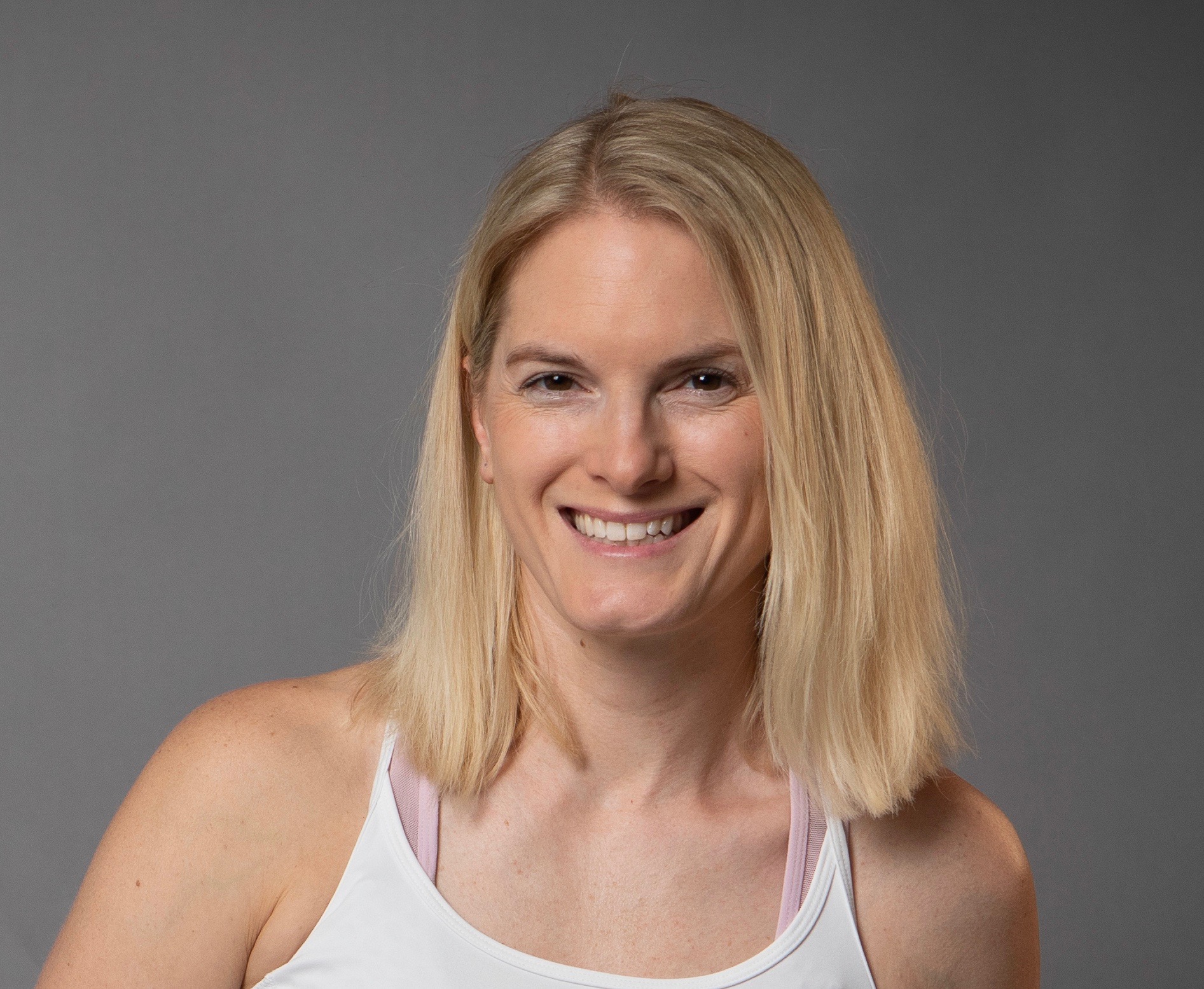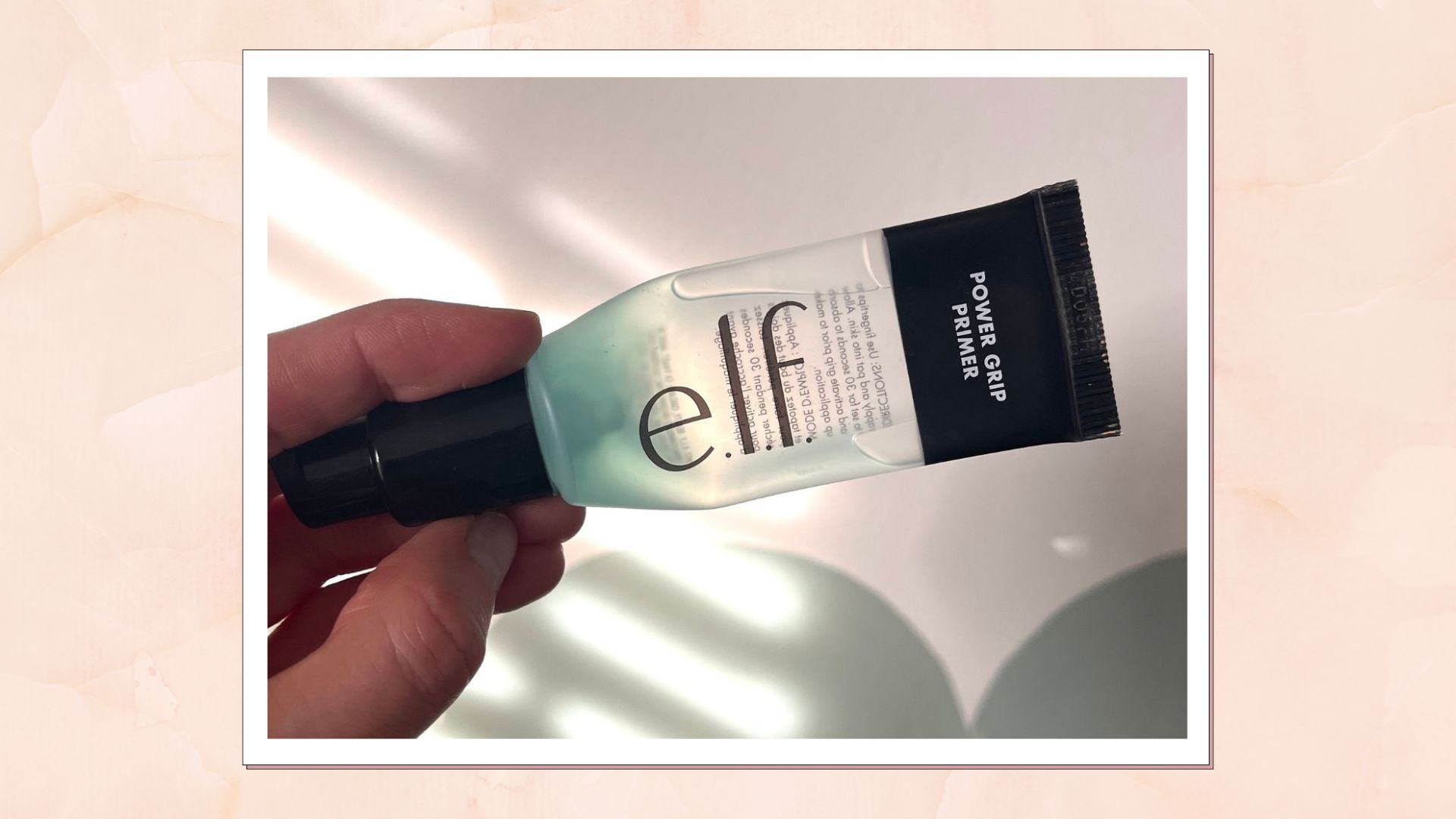I did 50 squats a day for two weeks - these are the surprising benefits I found
50 squats a day sounds like a lot, but it's more doable than you might think. Here, health writer Kat Storr reveals everything she learnt over the fortnight

Squats work most of the muscles in the lower body, making them one of the best strengthening exercises you can do. Yet, not everyone has the time to get to the gym or do a dedicated weights session at home, so health writer Kat Storr set out to determine the benefits of doing 50 squats a day as she went about her normal life.
Sometimes it's easy to forget that we've all been squatting since we were tiny. It's an essential part of strength training for women but I remember looking in awe at my children sitting in a squat position while playing in the garden or on the floor with me. Just seeing them comfortable like that for minutes at a time made my hips and knees twinge.
As we age, our hips, knees and upper legs become tight and we lose muscle mass and tone. Along with dietary changes - such as eating high-protein foods like the best protein powders for women, for example - squats can help avoid this. They can also improve your posture and mobility. Trust me, I saw the benefits of doing 50 squats a day in just two weeks.
Benefits of 50 squats a day
1. Improved leg strength
On the first day, I decided to do my squats in the morning to get them done before the day properly began. I hadn’t thought about how it would feel to do 50 in one go, so I just went for it. It was hard! The first 10 felt fine but keeping the pace to carry on to 50 was difficult. My knees were clicking which was uncomfortable and my glutes were burning. I also wasn’t sure what to do with my arms.
By the end of the first week, my 50 squats slotted easily into my daily routine, and I enjoyed doing them and my regular Pilates and strength training classes. I enjoyed the feeling of having a stronger lower body and by the end of the two weeks, everything felt tighter and more toned.
"When done correctly, squats work nearly every major muscle group - legs, hips, glutes, core, and even your back. Squats are excellent for calorie burning, injury prevention, core strengthening, and building muscle definition in all the right places," says Pilates instructor Katie James.
When it came to changes to my body, I felt like my bottom looked more rounded and toned and my inner and outer thighs also felt stronger. I slept well after doing them and found it much easier to do squats in my Pilates and weights classes.
Sign up for the woman&home newsletter
Sign up to our free daily email for the latest royal and entertainment news, interesting opinion, expert advice on styling and beauty trends, and no-nonsense guides to the health and wellness questions you want answered.

Katie James is a certified Pilates instructor and strength specialist. She trained as a professional dancer and experienced the benefits of Pilates from early in her career, attending regular studio and mat work classes which kept her lean, strong and prepared for the athletic and intensive demands of a dancer’s life. She learned the important role that Pilates could play in injury prevention and rehabilitation and recognised the power of intelligent movement.
2. Strengthens bones and joints
Squats improve bone, joint, and muscle strength. "This is essential as we go through perimenopause and menopause," says James, since this is when we lose the protective effects of oestrogen.
"Plus, squatting can help reduce the risk of osteoporosis by reinforcing the muscles and ligaments around your knees," she notes.
I found that varying the types of squats I did helped with this. For example, I swapped out my regular squats for some sumo squats, where you place your feet slightly wider than hip-width apart. I sat closer to the ground in this position and felt this helped with my hip flexibility, which is important as my hips get very tight if I've been sitting down a lot. I also felt the burn in this position more in my inner thighs.

Varying up the types of squat you do can help you find one that's most comfortable.
3. Boost core strength
I also started to notice improvements in my core strength. I began trying to put my arms straight up next to my ears during my squats - a position similar to the 'chair pose' (utkatasana) in yoga.
Doing this made me engage my abdominal muscles more, maintain a flat back and sit further into my squat. It also slowed me down, which made every movement feel more effective.
Core strength improvements benefit posture and balance by keeping your hips, spine, and shoulders aligned. It's also one of the easiest ways to alleviate lower back pain.
4. You can do them any time
After a few days, I switched up my morning squat routine and did them in the evenings instead. Having more time, instead of trying to cram them in before work, meant I focused on my form more and slowed down.
I also enjoyed moving my body before going to sleep. If my husband and I had spent the evening sitting on the sofa, the squats felt needed to loosen my body up again.
The great thing about doing 50 squats a day is that you don't have to do them all in one go. For example, doing 10 at a time means you won't get too sweaty or out of breath, so you can do them wherever you are - at home, in the office, waiting for the train, on a bathroom break, wherever. This is known as exercise snacking.
5. Anyone can do them
Injuries and mobility issues aside, almost everyone can do a squat. It's one of the most basic strength training movements and you don't need any equipment so you can do them whether you've been working out for years or are brand new to weighted workouts.
My husband is always intrigued by fitness challenges I do - which include wearing a weighted vest for walking and wearing barefoot shoes for a few weeks - but he doesn’t usually want to join me. Funny that. However, he wanted to get involved when I started doing my evening squats. He plays football and cycles a lot so he thought it would be beneficial to have some extra glute and hamstring strength.
We took turns squatting and counting out loud together, which might sound cringey to some but it really helped motivate me. He helped me with my form and encouraged me to squat lower to really feel the burn. I also followed instructions from Katie James, who told me to imagine I was trying to sit on a chair far behind me and to make sure I was leaning back on my heels slightly. This helped with the clicky knees.
Taking it slow and alternating with my husband made things easier but my glutes and quads were still burning by the end, especially during the first week.
6. Squats boost longevity
There are many ageing tests around - from quizzes to measure your fitness age to your metabolic age. However, research suggests that simply being able to sit and rise from the floor without using your hands for support is a sign of a longer life.
The study, published in the European Journal of Preventive Cardiology, found that better musculoskeletal fitness - assessed by this floor-to-standing movement - was a "significant predictor" of mortality among those aged between 51 and 80.
With this in mind and the knowledge that I can spread my exercises throughout the day, I’d really like to carry on with my routine of doing 50 squats a day. I'm aiming to continue now that I know how quickly you can do them and how effective they can be.
How to do a proper squat
- Stand with your legs hip-width apart, toes pointed out slightly.
- As if you're trying to sit on a chair behind you, push your knees out over your toes and 'sit' down. Try to 'sit' parallel with the bottom of your squat coming in line with your knees - but don't push if this is uncomfortable. Just go as low as you can.
- Using power from the heels of your feet, push back up to standing.
- You can keep your arms down by your sides, clasped together in front of you, or raised above your head - wherever is most comfortable.
"Avoid turning your knees inward as you descend, as it can stress the joints. Instead, keep your knees aligned with your toes and engage your core to avoid rounding your back. Going too deep can put undue pressure on your spine, so if you feel discomfort, try a partial squat instead," says James.
"And, remember, breathing is key. Inhale as you go down, and exhale as you stand back up."
James also likes to mix things up in her classes by using resistance bands, weights and Pilates balls when doing squats. This will give you greater quad- and glute burn. It can also help work your arms and shoulders at the same time.
Tips for doing 50 squats a day
- Spread them out: There's no reason why you have to do the 50 squats at once - unless you're like me and prefer to get them done. You could spread your squats out throughout the day. For example, ten while you're waiting for the kettle to boil, ten after you go to the loo, ten before you go up the stairs, ten while watching television, and ten while brushing your teeth.
- Do different types of squats: As I got into a rhythm, doing 50 regular squats began to feel easier so I decided to try some other types. I added in curtsy squats - alternating with 10 on each leg. I found this eased the pressure on my left knee and increased the burn in the outside of my legs and glutes.
- Remember to stretch: This is especially important if you do 50 squats at once, although daily stretching will help you sit lower in your squat regardless of when you do them. Stretch out your quadriceps (thighs), hamstrings, glutes (buttocks), and lower back, using one of the best stretching apps if you need ideas.
- Add weight: You might decide that bodyweight squats aren't challenging enough. To make them harder, personal trainer Anya Russell suggests holding "dumbbells in each hand at your sides for extra weight during regular squats." You could also use a pick of the best kettlebells.
- Work them into your other workouts: Squats are great for strengthening the muscles needed for other sports, such as running or cycling. As James explains: “They mimic natural movements and reinforce key muscles, enhancing the stability and power needed for these activities.”

Anya Russell is a certified personal trainer. She is a Girls Gone Strong qualified personal trainer and group fitness coach serving women in all stages of their lives whether it be pre-pregnancy or post-menopause – with 12 years experience as a trainer and over 10,000 in person as well as online personal training sessions and 1000+ fitness classes taken during that time.
A word of warning
As with all exercise, seek advice from a PT or physio if you have any pre-existing health problems or mobility issues before trying to do 50 squats a day. Russell says squats put pressure on your knee joints so as mentioned above, your alignment must be correct.
“Starting with bodyweight squats or using support (like wall Pilates or a chair workout) can help build strength safely. If knee or back pain persists, consider modifying the squat depth or consulting a personal trainer for guidance,” she says.

Kat Storr has been a digital journalist for over 15 years after starting her career at Sky News, where she covered everything from world events to royal babies and celebrity deaths. After going freelance eight years ago, she now focuses on women's health and fitness content, writing across a range of UK publications.
From perimenopause to the latest fitness trends, Kat loves researching and writing about it all. She's happy to give any fitness challenge a go and speaks to experts about wellbeing issues affecting people every day.
-
 This £10 primer is the only thing that can make my foundation last past lunchtime
This £10 primer is the only thing that can make my foundation last past lunchtimee.l.f. Power Grip Primer is the budget buy our oily-skinned Beauty Editor, Jess Beech, can't live without
By Jess Beech Published
-
 The eye cream Reese Witherspoon uses to banish 'concealer creasing' and puffiness was already a bargain - now it's on sale
The eye cream Reese Witherspoon uses to banish 'concealer creasing' and puffiness was already a bargain - now it's on saleThe inexpensive eye cream Reese Witherspoon uses to reduce puffiness, dark circles and creases in her concealer is even more affordable than usual today.
By Charlie Elizabeth Culverhouse Published